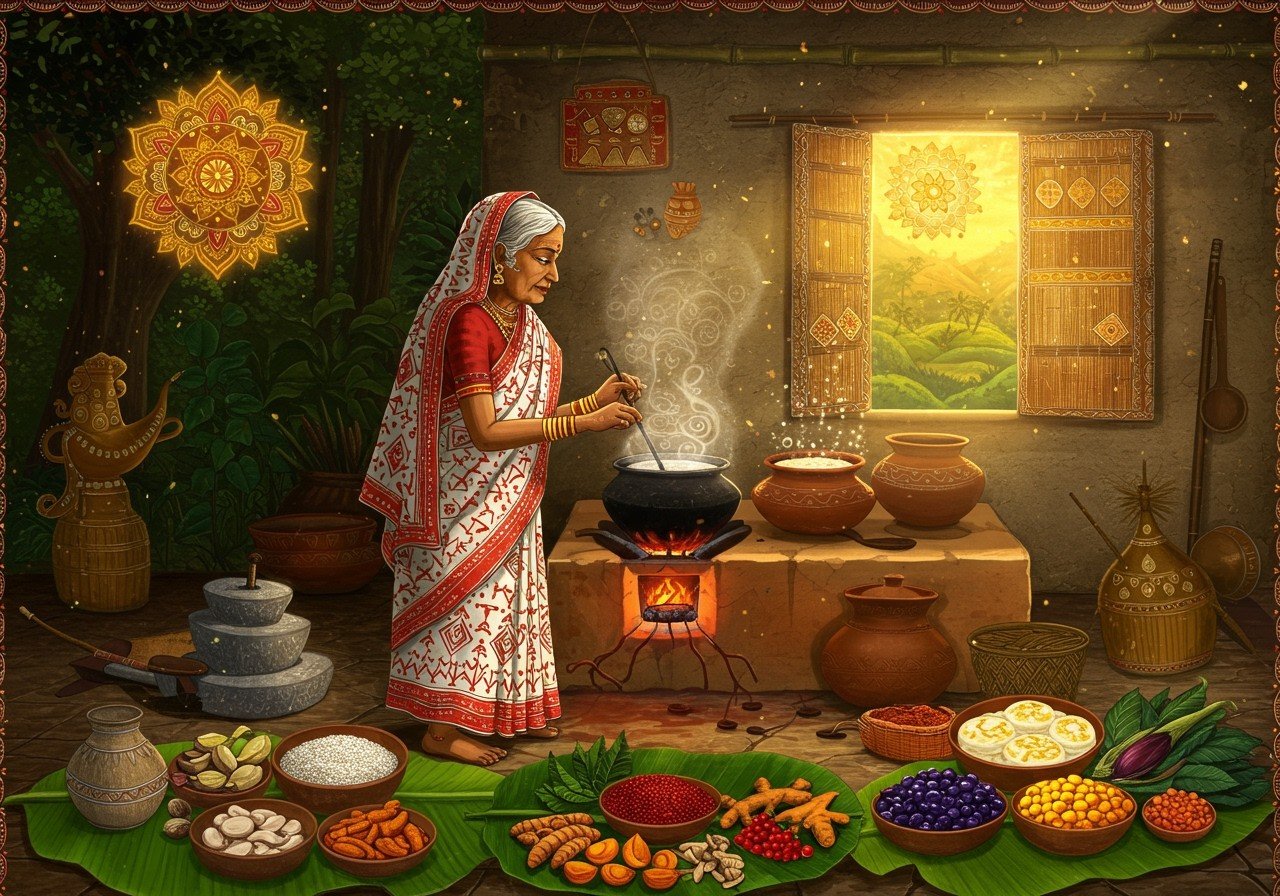
Tribal cuisine offers a unique culinary experience, rich in tradition and culture. These traditional foods are not just about feeding the body; they hold deep cultural significance and represent the heritage of Native American tribes. Recipes passed down through generations play a vital role in rituals and gatherings, reflecting a community’s identity and way of life.
Exploring the Heart of Native American Cuisine
Traditional tribal cuisine includes a diverse array of foods central to Native American diets. The ‘Three Sisters’ – corn, beans, and squash – are staple ingredients, often forming the base of many dishes. Wild rice holds sacred value for tribes in the Great Lakes region, while game meats like bison, deer, and elk provide essential nutrients. Coastal tribes rely on fish and seafood, preparing them using ancient methods. Native fruits and nuts, such as acorns and berries, are used in both savory and sweet dishes. Traditional beverages like herbal teas and corn-based drinks often accompany these meals.
Understanding these foods helps appreciate the variety and significance they hold in tribal communities.
Ingredients and Culinary Practices: A Deeper Look
Tribal cuisine is defined by its unique ingredients and cooking methods. Foraging wild herbs, roots, and mushrooms adds flavor and nutrition to dishes. Traditional preservation techniques like smoking and drying ensure food sustainability. Earth ovens and open-fire cooking impart distinct flavors, while clay pots and stone tools showcase innovation in meal preparation. Communal cooking strengthens tribal bonds, with recipes and techniques passed down orally through generations. This communal aspect is essential in maintaining cultural traditions.
The Cultural Significance of Food in Tribal Life
Food holds deep cultural significance within tribal communities. It is intertwined with tribal identity and often used in ceremonies to honor the earth and ancestors. Preparation and sharing of food express cultural values and build community ties. Certain foods carry symbolic meanings, conveying messages and stories that foster continuity and resilience. Food acts as a bridge between past and present, preserving heritage amidst modern changes. Efforts to revive indigenous food practices promote health and sustainability, ensuring these traditions endure.
A Culinary Exploration of Native American Dishes
Native American cuisine embraces indigenous ingredients and traditional methods, offering dishes that reflect the vibrant heritage of the tribes. This culinary journey reveals a world where food is more than sustenance; it is a tapestry of cultural significance and shared history.
Traditional Delights: Exploring Culinary Heritage
- Fry Bread: A beloved dish, though its origins spark debate due to the use of wheat flour. The process involves deep-frying dough made from flour, baking powder, oil, milk, and salt, traditionally using lard. Fry bread serves as a base for tacos or a side to chili. It’s a simple yet satisfying staple in many Native American communities.
- Buffalo Stew: A hearty and nutritious meal featuring buffalo meat, known for its high protein and lower fat content compared to beef. Often incorporating vegetables like carrots and potatoes, the stew simmers to rich perfection, embodying the essence of resourcefulness in Native American cooking.
- Maple and Butternut Squash: A celebration of indigenous ingredients, featuring butternut squash enhanced by the sweetness of maple syrup. This simple yet flavorful dish showcases the harmonious blend of nature’s gifts and provides a comforting, wholesome meal. The vibrant colors and earthy sweetness create a truly delightful sensory experience.
- Wild Greens Salad: A testament to the resourcefulness of Native American cooking, this salad utilizes foraged greens and seasonal herbs. Each bite offers a taste of the natural world, connecting diners to the land and its bounty. This nutritious and refreshing salad celebrates the diversity of edible plants.
Unique Flavors and Ingredients
- Pine Nut Crusted Catfish: An innovative dish where catfish is crusted with pine nuts and cornmeal before frying. Walnuts offer a budget-friendly alternative to pine nuts. This dish highlights the creativity and adaptability of Native American cuisine. The combination of textures and flavors creates a truly memorable culinary experience.
- Pueblo Pork Roast: A flavorful dish infused with Southwestern spices, slow-cooked to perfection. This dish represents the heart of Pueblo culinary traditions. The tender pork absorbs the rich flavors of the spices, creating a truly satisfying meal.
- Acorn Nut Bread: A testament to resourcefulness, this bread uses ground acorns. This unique ingredient showcases the ingenuity and adaptability of Native American cuisine in utilizing available resources. The bread has a distinct nutty flavor and dense texture, offering a taste of history.
- Simple Berry Pudding: A delightful sweet treat made with berries, flour, water, and sugar. Traditionally, chokecherries or blueberries are used, creating a simple yet satisfying dessert. This pudding is a celebration of nature’s sweetness and a testament to the resourcefulness of Native American culinary traditions.
Honoring Tradition and Innovation: Preserving Culinary Heritage
- Pemmican: A traditional preservation method combining dried, shredded meat with fat and sometimes berries. This energy-rich food sustained tribes during long journeys, showcasing their ingenuity in preserving food. Pemmican reflects the deep understanding of food preservation and resourcefulness that characterized traditional Native American life.
- Cedar Plank Salmon: A culinary practice from Pacific Northwest tribes like the Nez Perce and Umatilla, this dish involves grilling salmon on cedar planks for a smoky flavor. This technique infuses the salmon with the aromatic essence of cedar, creating a dish that is both flavorful and culturally significant. The smoky aroma and the moist, flaky salmon offer a truly unique culinary experience.
- Three Sisters Stew: A symbolic dish featuring corn, beans, and squash, representing agricultural harmony. Often seasoned with wild herbs and sometimes including venison or rabbit, this stew is a celebration of the interconnectedness of nature and sustenance. It represents the wisdom of traditional Native American farming practices.
Savoring Authentic Native Flavors: A Culinary Adventure
- Blue Corn Mush: A comforting porridge made from blue cornmeal, a staple in several Native American diets. Its rich blue hue and unique flavor profile offer a distinct culinary experience. This simple dish is a testament to the versatility of corn and its importance in Native American cuisine.
- Salmon Candy: Popularized by the Tlingit and Haida tribes, this dish involves smoking and sweetening salmon with maple syrup or brown sugar for a caramelized glaze. The result is a sweet and smoky treat that reflects the ingenuity of preserving and enhancing the flavors of salmon. This unique preparation method creates a truly unforgettable flavor.
- Blue Bread: A Navajo Nation specialty made with blue cornmeal and juniper ash. The juniper ash imparts a unique flavor and contributes to the bread’s distinctive blue color. This bread is a testament to the creativity and cultural significance of Native American baking traditions. Its unique flavor and vibrant color make it a true culinary treasure.
- Wild Rice Hamburgers: An innovative twist on a classic, combining wild rice with ground beef for a unique burger experience. The nutty flavor of wild rice complements the savory beef, creating a dish that is both familiar and excitingly new. This recipe highlights the adaptability of traditional ingredients in contemporary cooking.
Poojn.in: Supporting Traditional Indian Cooking
Poojn.in offers essential items that connect traditional cooking practices with modern convenience. While exploring tribal and indigenous cuisines, having the right tools and ingredients is important. Our selection includes traditional cookware and pure ingredients that maintain the authenticity of age-old recipes.
For those interested in traditional cooking methods, Poojn.in provides:
- Pure copper vessels for cooking and serving
- Traditional brass utensils
- Natural spice grinding stones
- Clay cooking pots
- Bronze cookware
These items are carefully selected to meet the standards of traditional Indian cooking practices. Each product on Poojn.in comes with detailed information about its use and significance in Indian cooking traditions.
Shop Traditional Cookware at Poojn.in
Note: Product availability may vary. Please check the website for current stock and prices.
Embracing the Legacy of Tribal Flavors at Poojn.in
Exploring Native American cuisine is like opening a window to a world filled with history, culture, and creativity. Each dish, from the simple fry bread to the innovative wild rice hamburgers, carries the spirit of the tribes and their deep connection to the land. By trying these recipes, you not only enjoy unique flavors but also honor the rich traditions that have been passed down through generations.
This journey into indigenous flavors reminds us of the importance of preserving and celebrating cultural heritages. As we savor these dishes, we connect with the stories and wisdom of the past while embracing the innovations of today. Whether you are a seasoned cook or a curious explorer, Native American cuisine offers a flavorful adventure that enriches both the palate and the soul.
Green Mung Dal
Supari (Areca Nut)
FAQs: Delving into Indigenous Culinary Traditions
What defines traditional tribal foods? Traditional tribal foods vary significantly among tribes, often incorporating ingredients like wild game, fish, grains, nuts, and berries, deeply connected to their environment and seasonal availability.
What are the common ingredients in tribal cuisine? Common ingredients include maize, beans, squash, herbs, native spices, and locally sourced meats and fish, reflecting the tribes’ connection to their land.
What makes tribal cooking methods unique? Tribal cooking often involves roasting, smoking, and boiling, utilizing open fires or earth ovens, which impart distinct flavors and represent traditional practices.
Why is food culturally significant in tribal communities? Food transcends mere sustenance, serving as a vessel for preserving traditions, transmitting knowledge, and fostering social and spiritual connections within the community.
Are there specific rituals related to tribal cuisine? Yes, many tribes have rituals surrounding food preparation and consumption, including ceremonial feasts, harvest celebrations, and ancestral offerings, highlighting the cultural significance of food.
How can one experience tribal cuisine today? Explore tribal cuisine by attending tribal festivals, dining at restaurants specializing in indigenous flavors, or trying traditional recipes at home, offering a direct connection to these rich culinary traditions.
Is tribal cuisine healthy? Often considered healthy due to its emphasis on fresh, natural ingredients and minimal processing, tribal cuisine focuses on whole foods like grains, vegetables, and lean meats, promoting a balanced diet.
Can tribal cuisine be adapted for modern kitchens? Absolutely! Many traditional ingredients and cooking methods can be integrated into contemporary recipes, allowing you to savor indigenous flavors in your own home.


